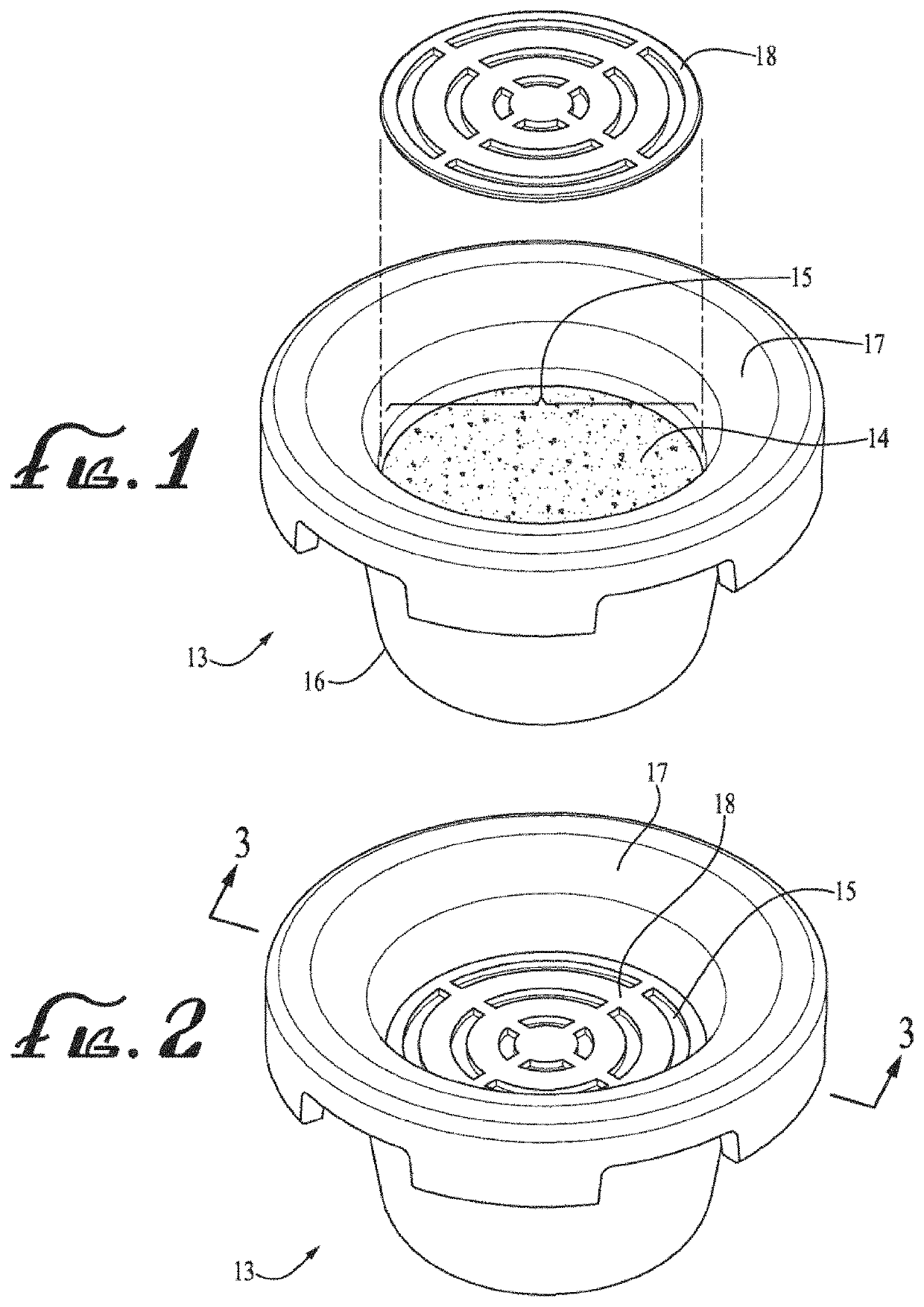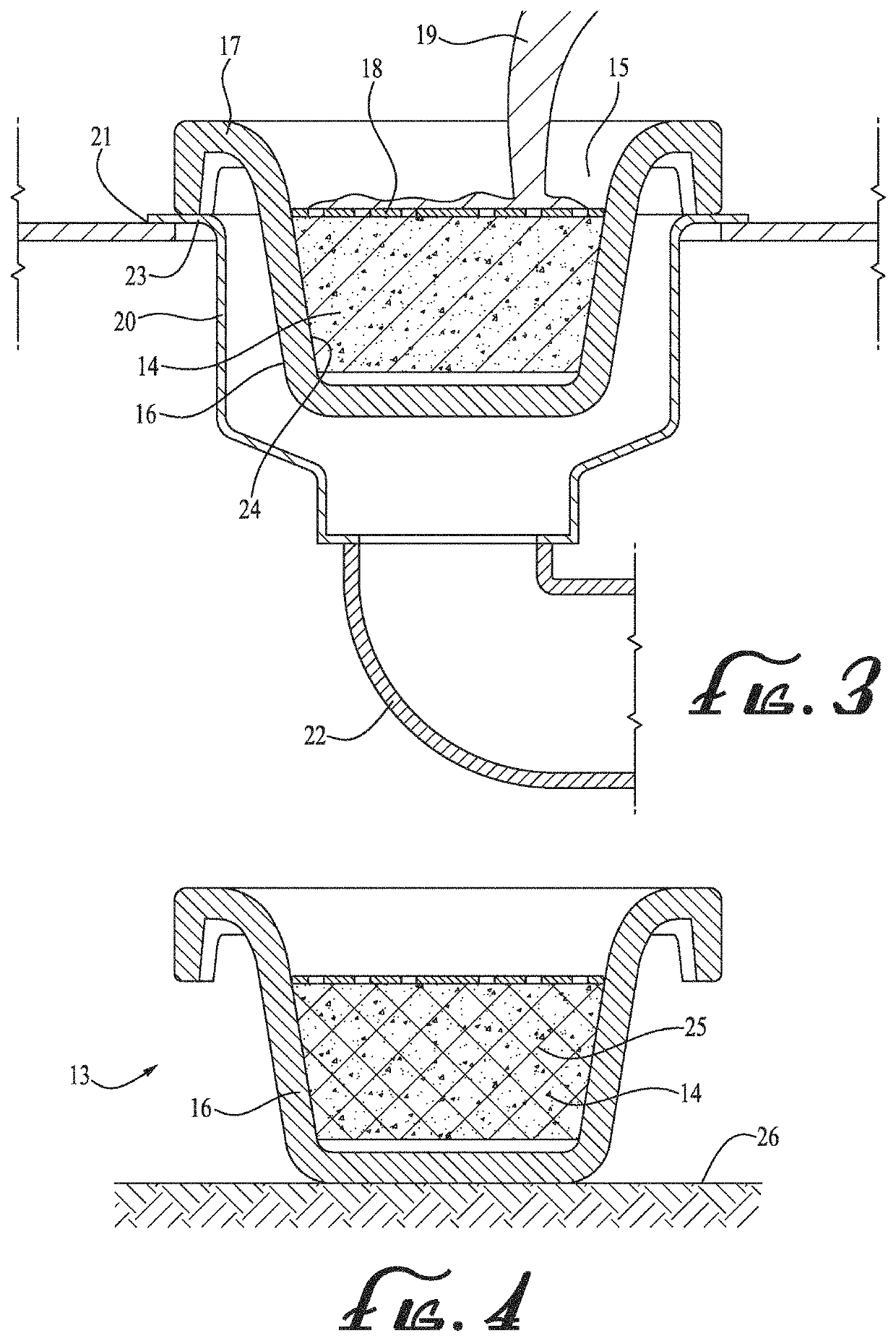FOG disposal article
a technology of disposal articles and fog, applied in the field of articles, can solve the problems of time-consuming and even dangerous disposal of fog in hot liquid form, affecting the quality of cooking byproducts, and causing additional mess, so as to reduce the risk of contamination, and avoid contamination. , the effect of reducing the risk of contamination
- Summary
- Abstract
- Description
- Claims
- Application Information
AI Technical Summary
Benefits of technology
Problems solved by technology
Method used
Image
Examples
embodiment 13
[0058]Turning to the drawings, FIG. 1 illustrates a first article embodiment 13 for disposing of FOG, in accordance with various aspects of this disclosure. The article 13 may comprise absorbent material 14 contained by an outer body perimeter (i.e., exterior membrane forming a body shape) 16, and a top opening 15 above the absorbent material 14 for receiving FOG there-through, the top opening 15 defined by a perimeter rim 17 having a width wider than the body perimeter 16.
[0059]FIG. 2 is a top perspective view of the article of FIG. 1, in accordance with various aspects of this disclosure. The article 13 may also comprise a cover 18 for placement over both the top opening 15 and the absorbent material 14 thereunder. The cover 18, in the embodiment 13 shown, when placed over the top opening 15 defined by the perimeter rim 17, may comprise a design for distributing FOG 19 more evenly over the absorbent material 14.
[0060]FIG. 3 is a cutaway cross sectional view of the article of FIG. ...
embodiment 27
[0064]FIG. 6 is a top perspective view of the unseparated article of FIG. 5, in accordance with various aspects of this disclosure. And FIG. 7 is a cutaway cross sectional view of the article of FIG. 6, placed in a kitchen sink drain, in accordance with various aspects of this disclosure. As shown in FIG. 6, the liner piece 35 may be placed inside the shell / container 28 (and the liner piece 35 may also be removable from the shell / container 28), and as shown in FIG. 7 the filter 30 may be placed over the top opening 31 and the absorbent material 29, and the article 27 may be placed in the drain 20 along a bottom kitchen sink surface 21, with the legs 33 of the perimeter rim 32 resting along the top of the drain 23 so that the shell / container 28 stably rests inside the drain 20. The trough 34 formed by the absorbent side exterior liner / membrane 36 and the downward-middle sloping wall of the liner 35 may capture any excess FOG 19 that was poured into the filter 30 and top opening 31 bu...
embodiment 42
[0066]FIG. 9 is a cutaway cross sectional view of the article of FIG. 8, placed in a kitchen sink drain, in accordance with various aspects of this disclosure. As shown in FIG. 9, the hollowed inward part of the drain 20 may have a middle section 51 and a bottom section 52, and the outer membrane 38 may also have a middle section 53 and a bottom section 54 roughly conforming to the middle section 51 and bottom section 52. As shown in FIG. 9, in some examples, the cross section of the middle section 53 may be greater than the cross section of the bottom section 54, the height of the middle section 53 may be greater than the height of the bottom section 54, and / or the slope of the middle section 53 may be greater than the slope of the bottom section 54. FIG. 10 is a top perspective view of a fourth article embodiment for disposing of FOG, in accordance with various aspects of this disclosure. FIG. 11 is a cutaway cross sectional view of the article of FIG. 10, in accordance with vario...
PUM
| Property | Measurement | Unit |
|---|---|---|
| width | aaaaa | aaaaa |
| width | aaaaa | aaaaa |
| height | aaaaa | aaaaa |
Abstract
Description
Claims
Application Information
 Login to View More
Login to View More - R&D
- Intellectual Property
- Life Sciences
- Materials
- Tech Scout
- Unparalleled Data Quality
- Higher Quality Content
- 60% Fewer Hallucinations
Browse by: Latest US Patents, China's latest patents, Technical Efficacy Thesaurus, Application Domain, Technology Topic, Popular Technical Reports.
© 2025 PatSnap. All rights reserved.Legal|Privacy policy|Modern Slavery Act Transparency Statement|Sitemap|About US| Contact US: help@patsnap.com



